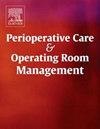Ultrasound guided ilioinguinal, iliohypogastric nerve block, transversus abdominis plane block and quadratus lumborum block for scheduled cesarean delivery: A randomized clinical trial
IF 1
Q2 Nursing
Perioperative Care and Operating Room Management
Pub Date : 2025-09-26
DOI:10.1016/j.pcorm.2025.100561
引用次数: 0
Abstract
Background
Optimal postoperative pain management is essential for enhancing recovery outcomes after cesarean delivery (CD). Regional anesthesia techniques, including ilioinguinal and iliohypogastric (II/IH) nerve blocks, transversus abdominis plane (TAP) block, and quadratus lumborum (QL) block, have gained recognition for their ability to provide effective analgesia while reducing reliance on systemic medications. These approaches are considered both safe and effective, particularly when performed under ultrasound (US) guidance. This study aims to evaluate and compare the efficacy of US-guided II/IH nerve block, TAP block, and QL block in postoperative pain management following elective CD.
Methods
A total of 150 patients aged 18- 45 years old undergoing elective CD were randomly assigned to receive one of the three US-guided nerve block techniques. Patients were allocated at random in three groups by sealed envelopes. A mixture of (0.5 % ropivacaine mixed with adrenaline 2 µ/mL) was injected after the completion of surgery under spinal anesthesia. The primary outcome was the duration of analgesia in hours. The secondary outcomes included pain scores assessment using the Numeric Rating Scale (NRS) at multiple time points postoperatively, opioid consumption, time to first analgesic request, and any complications related to the nerve blocks.
Results
Patients who received QL block reported significantly the longest duration of analgesia (36 h) compared to those who received II/IH block (22.4±9.6 h) with P value <0.001 (95 % CI), or those who received TAP block (28.36±7.7 h) with P value <0.001 (95 % CI). The QL group shows also the lowest NRS scores during the first 24 with no need for morphine compared to those in the other two groups who consumed (0.15±0.07 mg) and (0.068±0.07 mg) in II/IH group and TAP group respectively with P value <0.001(95 % CI).
Conclusion
The QL block offered strong and long-lasting pain relief, eliminating the need for opioids during the first 24 h after CD. The TAP block provided early analgesia but required additional pain control after 12 h. In comparison, the II/IH nerve blocks were effective for a shorter duration, with rescue analgesia needed as early as 6 h postoperatively.
超声引导髂腹股沟、髂腹下神经阻滞、腹横面阻滞和腰方肌阻滞用于剖宫产的随机临床试验
背景:最佳的术后疼痛管理对于提高剖宫产后的恢复效果至关重要。区域麻醉技术,包括髂腹股沟和髂下腹(II/IH)神经阻滞、腹横面(TAP)阻滞和腰方肌(QL)阻滞,因其提供有效镇痛的能力而获得认可,同时减少了对全身药物的依赖。这些方法被认为既安全又有效,特别是在超声引导下进行时。本研究旨在评估和比较美国导引下II/IH神经阻滞、TAP阻滞和QL阻滞在选择性CD术后疼痛管理中的疗效。方法150例年龄18- 45岁的选择性CD患者随机分配接受三种美国导引下神经阻滞技术中的一种。病人被随机分为三组,用密封的信封。脊髓麻醉下手术结束后注射(0.5%罗哌卡因与肾上腺素混合2µ/mL)的混合物。主要观察指标为镇痛持续时间(小时)。次要结果包括术后多个时间点使用数字评定量表(NRS)评估疼痛评分,阿片类药物消耗,首次镇痛要求的时间以及与神经阻滞相关的任何并发症。结果与II/IH组(22.4±9.6 h) (P值<;0.001)和TAP组(28.36±7.7 h) (P值<;0.001)相比,QL阻滞组镇痛持续时间(36 h)明显更长(95% CI)。与II/IH组(0.15±0.07 mg)和TAP组(0.068±0.07 mg)相比,QL组在不需要吗啡的前24小时的NRS评分最低,P值为0.001(95% CI)。结论:QL阻滞提供了强烈而持久的疼痛缓解,在CD后24小时内不需要阿片类药物。TAP阻滞提供了早期镇痛,但在12小时后需要额外的疼痛控制。相比之下,II/IH神经阻滞的有效时间较短,早在术后6小时就需要救援镇痛。
本文章由计算机程序翻译,如有差异,请以英文原文为准。
求助全文
约1分钟内获得全文
求助全文
来源期刊

Perioperative Care and Operating Room Management
Nursing-Medical and Surgical Nursing
CiteScore
1.30
自引率
0.00%
发文量
52
审稿时长
56 days
期刊介绍:
The objective of this new online journal is to serve as a multidisciplinary, peer-reviewed source of information related to the administrative, economic, operational, safety, and quality aspects of the ambulatory and in-patient operating room and interventional procedural processes. The journal will provide high-quality information and research findings on operational and system-based approaches to ensure safe, coordinated, and high-value periprocedural care. With the current focus on value in health care it is essential that there is a venue for researchers to publish articles on quality improvement process initiatives, process flow modeling, information management, efficient design, cost improvement, use of novel technologies, and management.
 求助内容:
求助内容: 应助结果提醒方式:
应助结果提醒方式:


